Anguilla's property market remains depressed

After several years of house price declines, Anguilla’s real estate market remains depressed, reflecting the contagious impact of the global crisis.
House prices started to decline in Anguilla in early 2009, according to a report by Scott Hauser of Sotheby´s International Realty. Property sales also fell, as foreign demand weakened. From 2009 to 2012, residential lots dropped around 50% to 75%, according to some local property experts. In 2013, residential property prices continued to drop, albeit at a decelerating pace.
Anguilla experienced a property price boom from 2004 to 2007. The sharp property price increases during the period were driven by strong foreign demand, partly the result of celebrity sightings which have made the island ‘chic’. Brad Pitt and Jennifer Aniston spent their final days as a couple in the island. Denzel Washington celebrated his 50th birthday in Anguilla.
Anguilla experienced a construction boom in 2005, as demand for real estate increased.
- A new extended runway enabled private jets to land easily on the island
- The Temenos development was launched, with its Golf Club (the first golf course in Anguilla)
- The Viceroy Anguilla Resort and Residences was also unveiled
However, construction activity almost ground to a halt by end-2008 due to financing difficulties faced by developers, coupled with a sharp drop in demand. Numerous tourism and residential projects were cancelled or delayed. These included the construction of The Flag project at Temenos was stopped, the Flag’s golf course development at Rendezvous Bay, the expansion plans for Altamer at Shoal Bay West, the Rendezvous Bay Hotel, the Privee at Shoal Bay, and the Fairmont Anguilla at Forest Bay, among others. After almost five years, construction activity was improving gradually.
In 2013, the economy declined by 0.9%, after an annual contraction of 5.5% in 2012 and a growth of 4.3% in 2011. Anguilla’s economy is projected to grow by a meagre 0.74% this year, according to the Eastern Caribbean Central Bank (ECCB).
Local price variations
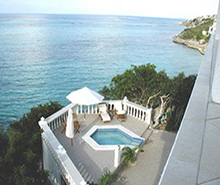
Despite being one of celebrities’ favorite vacation places, property prices in Anguilla have been lower than in nearby Caribbean islands, such as the BVI or US Virgin Islands.
Western Anguilla has seen the greatest amount of development over the past years. In Cul de Sac, a seven-bedroom luxurious villa situated in an exquisite 7,000 square foot gated location surrounded by 3.5 acres of landscaped gardens with its own private beach has a selling price of almost US$7 million.
In the Viceroy, located in Barnes Bay, villas and residences are priced from US$700,000 to as much as US$7 million.
In Meads Bay, one of the most beautiful beaches in Anguilla, an four-bedroom beachfront estate home was priced at US$3.9 million while an eight-bedroom lavish villa was priced at US$17.5 million.
In Rendezvous Bay, a four-bedroom luxury villa located in the CuisinArt Golf Resort and Spa was marketed from a price of US$6.95 million.
In the Island Harbour, an eight-bedroom villa near the Shoal Bay was valued at US$6.5 million. On the other hand, in the Little Harbour, a six-bedroom villa with its own secluded cove beach and stunning views towards the mountains of St. Martin was valued at US$4.9 million.
Booming tourism fails to fuel economic growth
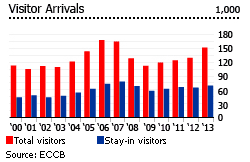
Anguilla’s economy relies mainly on tourism and financial services. Anguilla's tourist industry targets the luxury market, and caters mainly to visitors from North America and Europe.
After a tourism boom (2004-2006), tourism in the island declined sharply in 2007-2009, mainly due to the adverse impact of the global crisis.
Now Anguilla’s tourism sector is booming again. During the first nine months of 2014, the total number of tourist arrivals surged by 16.3% compared to the same period last year, to 135,095, according to Anguilla Statistics Department and the ECCB.
From January to September 2014:
- The number of stay-over visitors rose by 2.3% y-o-y to 53,969 people. The number of Canadians and Caribbean residents who visited Anguilla increased, while the number of Americans and Britons dropped.
- The number of excursionists soared by 28% y-o-y to 81,126 people
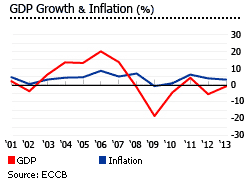
From 2004 to 2007, Anguilla’s average annual GDP growth was 15%. However, the economy contracted by 1.34% in 2008, plunged by 18.5% in 2009 and by another 4.44% in 2010. The economy posted a positive growth rate of 4.3% in 2011, but contracted again by 5.5% in 2012. In 2013, the economy declined by 0.9%. Anguilla’s economy is projected to grow by a meagre 0.74% this year, according to the Eastern Caribbean Central Bank (ECCB).
Unsurprisingly, Anguilla actually recorded a deflation (decrease in prices) of 0.73% in September 2014, its third quarter of annual decline in consumer prices. This is in sharp contrast with the 5.4% average inflation rate seen in 2003-2008, before the global crisis.
Construction activity improving gradually
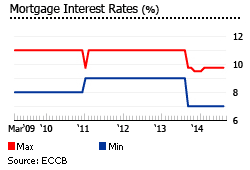
During the global crisis, construction activity slowed sharply, with numerous projects cancelled or delayed. Now, the construction of some property developments has already resumed, and other projects have been renovated:
- Zemi Beach Resort and Spa – a new resort and residential development covering more than 1,000 square feet of white-sand beachfront in Shoal Bay East. The resort, scheduled to open by mid-2015, will have 28 two- and three-bedroom residences priced from US$2 million to US$3.1 million. Zemi Beach Resort and Spa also includes other first-class amenities such as on-site restaurants, bars and lounges, a wine cellar, infinity-edge pools, a spa and fitness center, and an outdoor yoga terrace.
- Malliouhana Hotel and Spa – After a two-year closure, the legendary resort has recently undergone a full-scale renovation. It is set on 20 acres of beachfront land and offers 55 rooms, two beaches, two restaurants and bars, an extensive array of sports and fitness facilities, and a spa.
- CuisinArt Golf Resort and Spa – the phase two of the project is now under construction, which includes a new hotel featuring a ballroom to accommodate 200 people (the first in the island). The Reef by CuisinArt is also under construction, which is expected to have 62 rooms. The Reef is projected to open in 2015.
- Frangipani Beach Resort – situated on a beachfront location on Meads Bay, this luxurious 19-room boutique property has begun an extensive renovation of its reception area and pool.
- Anguilla Great House – this boutique beach resort has also undergone modernization, particularly its pool and pool deck area. It is famous for its lively cottages and breathtaking view of Rendezvous Bay.
- Cap Juluca – this development has reopened in December 2013 with some enhancements such as new menus and a refreshed Pimms, the resort’s signature restaurant.
- Anacaona Boutique Hotel – it has also recently reopened with the addition of a spa known as The Balinese Petite Spa.
Mortgage market shrinking
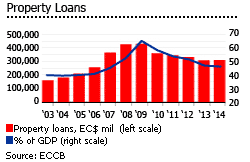
Anguilla’s mortgage market grew sharply, from an average of 40% of GDP from 2003 to 2006 to 45.1% of GDP in 2007, 52.2% of GDP in 2008, and to 64.6% of GDP in 2009, based on figures from the ECCB. However, the size of the mortgage market then sharply declined due to the impact of the global financial meltdown. In the second quarter of 2014, the mortgage market was about 46.1% of GDP.
In Q2 2014, total loans for property acquisition was about XC$309 million (US$114.44 million), down 5.7% from a year earlier, according to the ECCB. Of this, XC$231.8 million (US$85.85 million) was used for home construction and renovation, while the remaining XC$77.25 million (US$28.61 million) was used for house and land purchase.
Mortgage interest rates in Anguilla ranged from 7% to 9.75% in July 2014, down from 9% to 11% during the same period last year, according to the ECCB.
Mortgage interest rates are linked to the US prime rate or the US LIBOR. The Eastern Caribbean dollar, the official currency of Anguilla, is pegged to the US dollar, at XC$2.70 to US$1.
The maximum loan-to-value ratio is 70% of the property value, with loan terms of 15 years.
Foreign property ownership restrictions
While advertisements on timeshares and fractional ownership in Anguilla are widespread on the internet, there is no law in the islands that allows for these types of property ownerships.
With its area small (102 sq. km), the government restricts foreign land ownership. The Anguillan law prohibits non-belongers (local term for foreigners) to own sandy waterfront or beachfront properties. These locations are reserved strictly for tourism or commercial developments.
Government’s policy allows non-belongers to purchase real estate only on rocky coastline, Cliffside or inland lots of up to half acre for building a house with a minimum gross external floor area of 2,000 sq. ft. Construction should be completed within 18 months from the date the license is issued otherwise penalties are charged or worse, the land may be forfeited.
Celebrities’ haven
With its 33 immaculate white-sand beaches, Anguilla has become a haven for the rich and famous. Some of the recent celebrity sightings in the island included basketball legend Michael Jordan, actors Jonah Hill, Michael J. Fox, Liam Neeson, Ellen DeGeneres and Portia de Rossi, Sofia Vergara, billionaire Roman Abramovich, Shaquille O’Neal, rapper Drake and Queen Latifah, among others.
Yet Anguilla remains relatively uncrowded, and has avoided the damage done elsewhere by over-development.
A flat island, Anguilla is covered with arid scrub, growing out of solid rock, devoid of dramatic scenery. Visitors come to this island not for the scenery, but for its exceptional beaches.
Small and lightly populated, Anguilla’s residents (pop:15,000) are easy going. Since the island isn’t good for farming, its people became seafarers, known throughout the Caribbean for boat building and fishing skills.
Of its 33 pristine beaches, Shoal Bay is the most famous where A-list American celebrities have traditionally flocked. It made the decision in the 1980s to develop upper-end tourism, and concentrated on luxury hotels and villas.